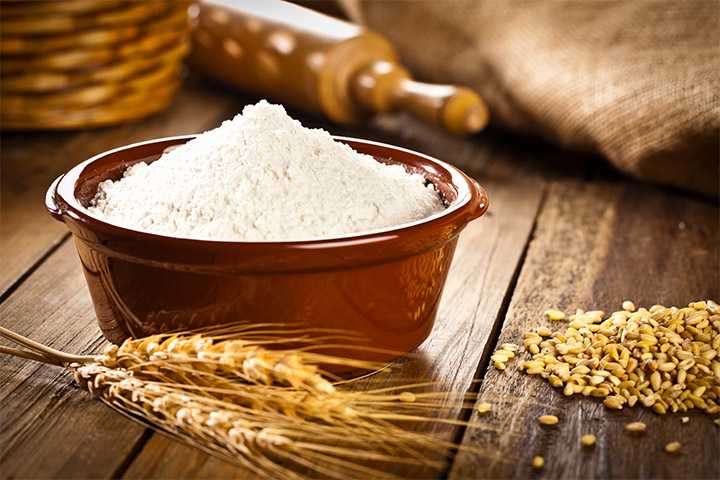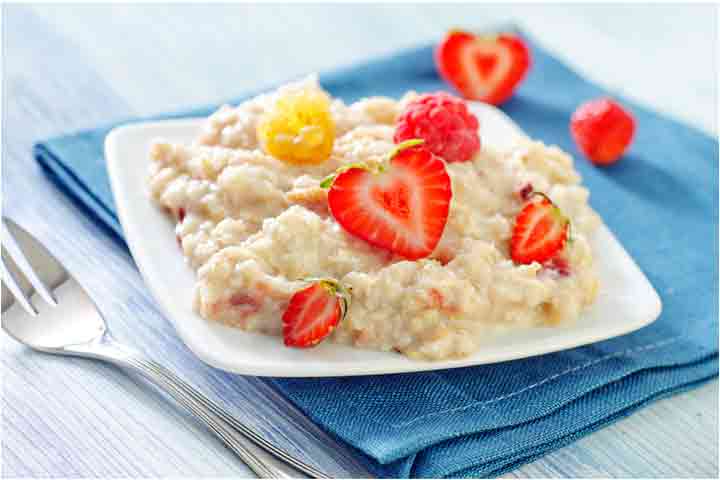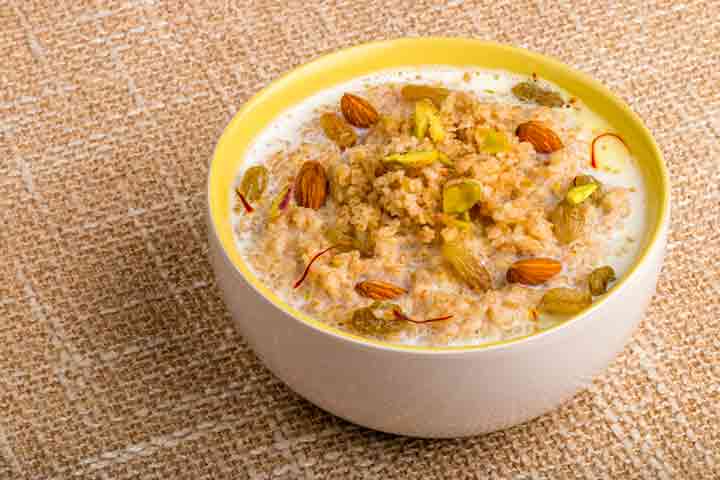While it is a staple for several families, parents may have questions regarding the use of wheat for babies. Wheat contains gluten, and gluten allergies are not uncommon. Therefore, many parents may consider delaying the introduction of wheat until the baby is eight to nine months old to prevent allergies. Read this post to know more about the benefits, the right age to introduce, nutritional value, possible side effects, and precautions to take while introducing wheat to your babies.
Is Wheat Good For Babies?
Wheat makes a suitable solid food for babies. It is a leading source of starch, energy, and other essential nutrients, such as protein, B-vitamins, dietary fiber, and phytochemicalsiXBioactive compounds found in plant-based foods that act as antioxidants and have antimicrobial effects (1). It is beneficial to give them whole wheat flour and its products rather than refined wheat products.
However, you need to introduce it at the right age to avoid any unnecessary health issues.
What Is The Right Age To Introduce Wheat To Babies?
You can introduce wheat to babies around the age of six months when they are likely to consume other single-grain infant cereals. Parents might want to delay introducing wheat to prevent wheat allergy or celiac diseases. However, several research studies show that delaying allergenic foods beyond six months of age does not guarantee the prevention of allergy (2).
If you have a family history of wheat allergy or gluten intolerance, then consult a pediatric nutritionist.
Nutritional Value of Whole Wheat Flour
Whole wheat flour is a whole-grain product that has all the three parts of the grain (germ, bran, and endospermiXFound in flowering plants, it is the tissue surrounding the seed and provides nutrients and protection to it) intact. It also has a higher nutritional value than refined or processed wheat flour, making it a better choice for meeting the baby’s nutritional requirements.
Below is the nutritional composition of one cup of whole wheat flour against the current recommendations of nutrients for babies (3) (4).
| Name | Amount | Unit |
|---|---|---|
| Water | 12.42g | – |
| Energy | 332Kcal | – |
| Protein | 9.61g | – |
| Carbohydrate, by difference | 74.48g | – |
| Fiber, total dietary | 13.1g | – |
| Calcium, Ca | 33mg | 210mg (0-6 months) 270mg (7-12 months) |
| Iron, Fe | 3.71mg | 6mg (0-6 months) 10mg (7-12 months) |
| Magnesium, Mg | 117mg | 30mg (0-6 months) 75mg (7-12 months) |
| Phosphorus, P | 323mg | 100mg (0-6 months) 275mg (7-12 months) |
| Potassium, K | 394mg | 500mg (0-6 months) 700mg (7-12 months) |
| Sodium, Na | 3mg | 120mg (0-6 months) 200mg (7-12 months) |
| Zinc, Zn | 2.96mg | 2mg AI (0-6 months) 3mg (7-12 months) |
| Manganese, Mn | 3.399mg | – |
| Selenium, Se | 12.7µg | 15µg (0-6 months) 20µg(7-12 months) |
| Thiamin | 0.297mg | 12µg |
| Riboflavin | 0.188mg | 1.7mg (0-6 months) 1.8mg (7-12 months) |
| Niacin | 5.347mg | 24µg (0-6 months) 32µg (0-12 months) |
| Pantothenic acid | 1.011mg | 125mg(AI) (0-6 months) 150 mg (7-12 months) |
| Folate, total | 28µg | – |
| Choline, total | 31.2mg | – |
Sources: U.S. Department of Agriculture and World Health Organization
The diverse nutritional composition of wheat makes it one of the best foods to include in your baby’s diet. The use of wheat germ oil is also prevalent.
Possible Health Benefits of Wheat For Infants
Regular consumption of wheat and its products in recommended amounts could provide the following health benefits to the baby.
- Nutrients: Whole wheat is rich in dietary fiber, essential amino acids, micronutrients, minerals, and phytochemicals (5). Being nutrient-rich, and also containing adequate carbohydrates increases the satietyiXThe feeling of fullness from a specific food value of whole wheat.
- Energy: 100 grams of wheat provides 332 kilocalories. High-energy grains such as wheat can help provide energy to babies for their rapid growth and development.
- Digestive health: Whole wheat is rich in dietary fiber, such as cellulose and hemicellulose. These insoluble fibers add bulk to the diet and regulate bowel movements, which could keep constipation at bay and enhance digestibility (6) (7).
- Gut health: Whole wheat contains insoluble fibers such as beta-glucan and short-chain fatty acids (SCFAs) such as acetate. Both these components are potential prebioticsiXCompounds that improve overall health by acting as food for the good bacteria present in the human gut that help enhance the gut microbiotaiXThe microorganisms present in the GI tract that aids in different body functions (8).
- Oral health: Wheat-based foods have thick granules that require chewing, which can be a good exercise for the jaw and gums. It can aid in the healthy development of the oral cavity.
Wheat can support the healthy development of your baby, if you make it part of a balanced diet.
Possible Side-Effects Of Wheat For Babies
The following are the likely side effects of wheat for babies.
- Antinutrients: Whole wheat, like several other grains, consists of some antinutrients such as phytic acid. Antinutrients are nutritional compounds that interfere in the absorption of other nutrients and make them unavailable for use (9). Soaking and fermenting of wheat can reduce these antinutrients.
- Irritable bowel syndrome: IBS is a metabolic condition in which the baby might experience recurrent abdominal pain, bloating, and disturbed bowel movements. Sensitivity to wheat could be one of the reasons for this (10). Pediatric consultation is a must to manage IBS.
- Wheat allergy: It is a condition in which an individual gets allergic to a certain protein found in wheat. General symptoms of wheat allergy are hivesiXInflamed itchy skin rashes due to an allergic reaction to food or medication, skin rash, nausea, sneezing, and headache (11). Most wheat allergies resolve during early childhood.
- Celiac disease: According to the data presented by Celiac Disease Foundation, the incidence of celiac disease in children is 21.3 per 100,000 people per year, while it is 12.9 per 100,000 people per year in adults. The research over several decades has shown a harmonious increase in these rates, with an annual rise of 7.5% on average. This complex autoimmune diseaseiXDiseases in which the body’s immune system mistakes healthy cells as foreign and attacks them occurs when the ingestion of gluten causes damage within the small intestine. It is prevalent in genetically predisposed individuals. Symptoms include vomiting, bloating, irritability, poor growth, diarrhea with very foul stools, malnutrition, and poor weight gain (12).
Babies with wheat allergy or celiac disease require complete elimination of wheat and wheat products from their diet.
Precautions To Take While Feeding Wheat To Babies
These precautions can help prevent any adverse effects of wheat consumption.
- Buy organic flour from a reputable store so that its quality could be assured.
- Start feeding wheat only once your baby has started eating single-grain solids such as rice and oats.
- As you begin feeding, follow a three to five-day wait rule to mark any signs of allergy or intolerance. If you notice any adverse effects, then discontinue feeding and consult a doctor.
- In the beginning, keep the quantity as small as one to two teaspoons. Once the baby gets comfortable, you may increase the quantity.
- Avoid using white flour or refined flour. Instead, prefer whole wheat flour that is rich in dietary fiber. High fiber food might be difficult to digest in the beginning. Therefore, make your baby drink enough water.
- Do not leave wheat flour near your baby. Wheat flour, when accidentally inhaled, could disturb the nasal passage and enter the bloodstream directly. It could trigger the immune system, thus resulting in an allergy.
While following these precautions, you may add a variety of wheat recipes to your baby’s weaning diet.
Ways To Include Wheat In Your Baby’s Diet
You can try these recipes and various others based on the age of the baby.
- As the baby starts weaning, you may introduce wheat through fortified wheat cereals, such as Cerelac
- You may also mix breast milk or formula milk in wheat-based cereals for infants. However, read the instructions given on the pack.
- Start with simple recipes like wheat porridge or mashed wheat mixed with dal (lentil) water or vegetable puree.
- As the baby gets comfortable with the grain, you may try introducing other wheat preparations, such as broken wheat porridge, bread, pasta, pancakes, and crackers.
Below are a couple of simple wheat recipes that you may try for your infant.
Wheat Recipes For Babies
These recipes are easy to prepare and provide nutrition to your little one.
1. Wheat porridge
This recipe is ideal for infant nutrition and can be given to babies who have just started eating solid foods. Along with wheat, this homemade baby food also contains yellow gram and almond powder. You can customize this recipe as per your baby’s preferences.
You will need:
- 2tbsp wheat flour
- 1tsp yellow gram powder
- 1tsp almond powder
- 1tbsp powdered jaggery
- 1 cup water
How to:
- Take the wheat flour, moong dal, and almonds in a thick bottom pan.
- Place the pan over medium heat and dry roast all these ingredients for five minutes. Continue roasting until the color of the ingredients changes to light brown.
- Let the ingredients cool and then transfer to a blender. Blend until it turns into a smooth powder.
- Sieve the powder to remove any chunks. Keep it in an airtight container and store the container in the fridge.
- To make porridge, add ½ cup of water and powdered jaggery to a vessel and boil until the jaggery melts. Filter the jaggery water through a strainer into a saucepan.
- Add the ingredient mix to the saucepan and mix everything slowly with a whisk. Make sure there are no lumps.
- Place the saucepan on a medium flame. Stir and cook until the porridge reaches the desired thickness.
- Serve while still warm to your baby. You can try adding pureed fruit or mashed fruits like apple, banana, and papaya to this porridge.
A mom of six shares her recipe for cream of wheat. She uses one cup of whole wheat flour and a little salt, whisked into five cups of water in a pot. The mixture is heated until it thickens (about five to ten minutes). She says, “This ‘cereal’ was most of my children’s first ‘baby food cereal.’ Does this taste exactly like boxed? No. It’s the whole grain, and the boxed isn’t. Cheaper? Much! It is about the same consistency as boxed, perhaps a little finer with the flour, and personally, I like it with coarse ground wheat to where it’s closer to a grit. You can use milk or cream instead of part of your water in the recipe to make it more true to its name, or even top it with a drizzle of heavy cream. You can sweeten simply with sugar or top with spices, fruits, etc- or my favorite is butter and honey. (i).”
2. Broken wheat porridge (Dhaliya)
Once your baby is comfortable with wheat porridge, you may try feeding broken wheat porridge or dhaliya that is slightly granular. Since this homemade baby cereal recipe contains cow milk, it is suited for babies older than 12 months.
You will need:
- 2tbsp broken Wheat
- 1tsp dried fruit powder
- 1tbsp jaggery powder
- 2 cup water
- 1 cup cow’s milk (whole)
How to:
- Boil cow’s milk and keep it aside. If your baby has a milk allergy or lactose intolerance, then you may skip the milk.
- Take two tablespoons of broken wheat in a pressure cooker with 3/4 cup of water and pressure cook it for three whistles.
- Add one-third cup of water to a pan and add to it the powdered jaggery. Boil the mixture until the jaggery melts completely. Filter the mixture using a strainer and set it aside.
- Take a pan and pour pressure cooked broken wheat, dried fruit powder, boiled milk, half cup water, and jaggery water into the pan.
- Put the pan on medium heat and cook the mixture while stirring constantly.
- Once you see the milk getting thick, lower the flame and cook with the lid closed for two to three minutes.
- Switch off the flame once broken wheat softens, and the porridge consistency is smooth. You may adjust the consistency as per your baby’s preference.
- Serve it to your baby while still warm.
















